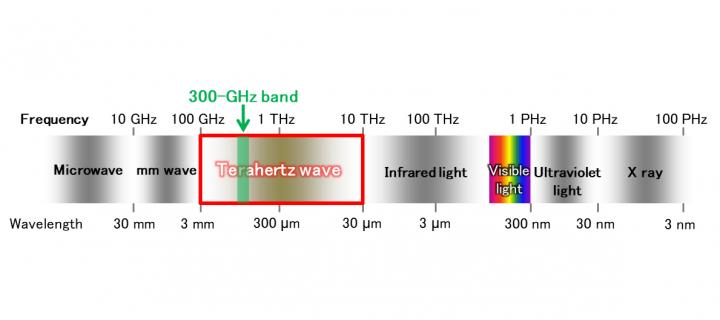
Collaborators Use Terahertz Waves to Probe Beyond 5G Communications
Partners from Osaka University and Rohm Co. Ltd., a developer and manufacturer of optoelectronics and semiconductor devices, deployed 300-GHz-band terahertz waves, functioning as an information carrier, to enable wireless communications of 8K ultrahigh definition (UHD) with a data rate of 48 Gbit/s. The advancement is the latest in the JST CREST project called “Development of terahertz integrated technology platform through fusion of resonant tunneling diodes and photonic crystals.”
Beyond the existing 5G system, the next-generation 6G mobile communication standard is poised to successfully transmit 8K and other UHD videos with low latency and power use. As the data rate of UHD video is very high, data must be compressed in the wireless transmission process. Compression with microwaves or millimeter waves results in delays and high power consumption, necessitating the development of an independent technology.
“In general, the higher the frequency, the greater the capacity to transmit information, with terahertz waves having a higher frequency than microwaves and millimeter waves,” said Julian Webber, an assistant professor at Osaka University. “We focused on terahertz waves in the 300-GHz band.”
The researchers assembled a two-channel terahertz transmitter by modulating the output of a laser pair with wavelengths in the 1.55-µm band. The team set the laser pair to exhibit a frequency difference in the 300-GHz band, with an 8K video signal source. An intensity modulator enabled the conversion into terahertz waves using an ultrafast photodiode.
Commercially available, uncompressed, full-resolution 8K video content that the team prepared itself served as the team’s 8K video signal source. The team output the content as a four-channel 12-Gbit/s signal, and then added an on/off keying (OOK) modulation signal to form a two-channel 24-Gbit/s signal.
“In general, such ultrahigh-speed data transmission experiments are performed using multilevel modulations via a complex system with high power consumption that uses offline or online digital signal processing,” said associate professor and team leader Masayuki Fujita. “The present real-time demonstration, which uses the simplest OOK format, shows the capability of ultrabroadband terahertz waves.”

Terahertz waves in the 300-GHz band. Courtesy of Osaka University.
After using sensitive terahertz coherent receivers, the collaborators split the waves from the two channels into four new channels. In a final step, they connected them to an 8K monitor via HDMI cable.
“Our achievement demonstrates the usefulness of terahertz waves and is expected to accelerate research and development activities for the realization of Beyond 5G and eventually 6G. Such uncompressed wireless transmission technology for UHD video will enhance the quality of telemedicine and telework, which are directly related to social issues, and will lead to the advancement of physical-cyber fusion by utilizing the big data of UHD video,” Fujita said.
/Buyers_Guide/Rohm_Co_Ltd/c12868